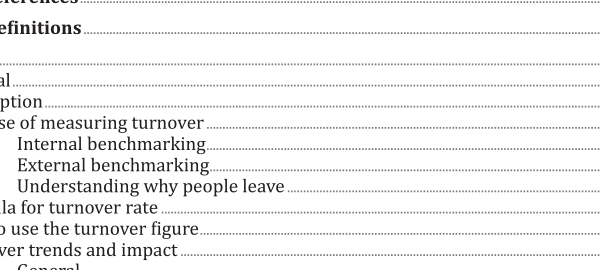ISO TS 30421:2021 pdf download – Human resource management — Turnover and retention metrics.
4.6 Turnover trends and impact 4.6.1 General Turnover levels can vary, for example between occupations and industries and from region to region. Users of this metric will possibly wish to track turnover on a month-by-month or year-on-year basis within the firm against industry or sector trends. There is no defined point at which employee turnover has a negative impact on organizational performance. Much depends on the organizational context and the kinds of labour markets in which the organization competes. Some employee turnover can benefit the organization, for example when a poorly performing employee is replaced by a more productive one. Moderate levels of turnover can also reduce staff costs where business activity is unpredictable or volatile. Employers need to be aware of employee turnover rates in their organization and how these affect the organization’s performance and ability to achieve its strategic goals. An appreciation of turnover level across occupations, locations and groups can help inform a comprehensive workforce planning strategy. The organization will possibly wish to examine which work groups are material to its core functions and monitor turnover levels in these accordingly. 4.6.2 Segmentation of turnover The crude turnover rate can be further broken down in many ways, such as by seniority, by job family or by criticality. Each organization, based on what is important to the optimal management of its human resources, has its segmentation priorities. Some segmentation approaches are described in 4.7. 4.6.3 explores segmentation based on criticality. 4.6.3 Criticality Segmentation of workforce turnover based on the criticality to the business. A critical position is a job role that has a direct and significant impact on organizational outcomes. Critical positions are identified by organizations as part of their organizational strategy, including critical aspects such as security, safety, growth and sustainability. Critical positions vary by industry, sector and organization type, such as for-profit or not-for-profit, and are not always high-level positions. The impact of the critical position relates to organizational performance, which can be affected positively or negatively by the performance of individuals occupying such positions, depending upon whether job performance is effective or ineffective and whether the role is left unfilled for a defined period.
These include induction, training and any coaching or instruction by a more experienced member of staff. For quite a while there will be lost productivity by virtue of the new hire not being able to deliver the performance standards and levels; potential lost business due to a leaver’s internal and external relationships; loss of institutional knowledge; adjustments to and by the existing team to new colleagues. There are also instances when there are mass exits due to one person leaving (e.g. sales teams) and other expenses. It is prudent to consider the monetary difference between the performance of the leavers and their replacements.
ISO TS 30421:2021 pdf download – Human resource management — Turnover and retention metrics






